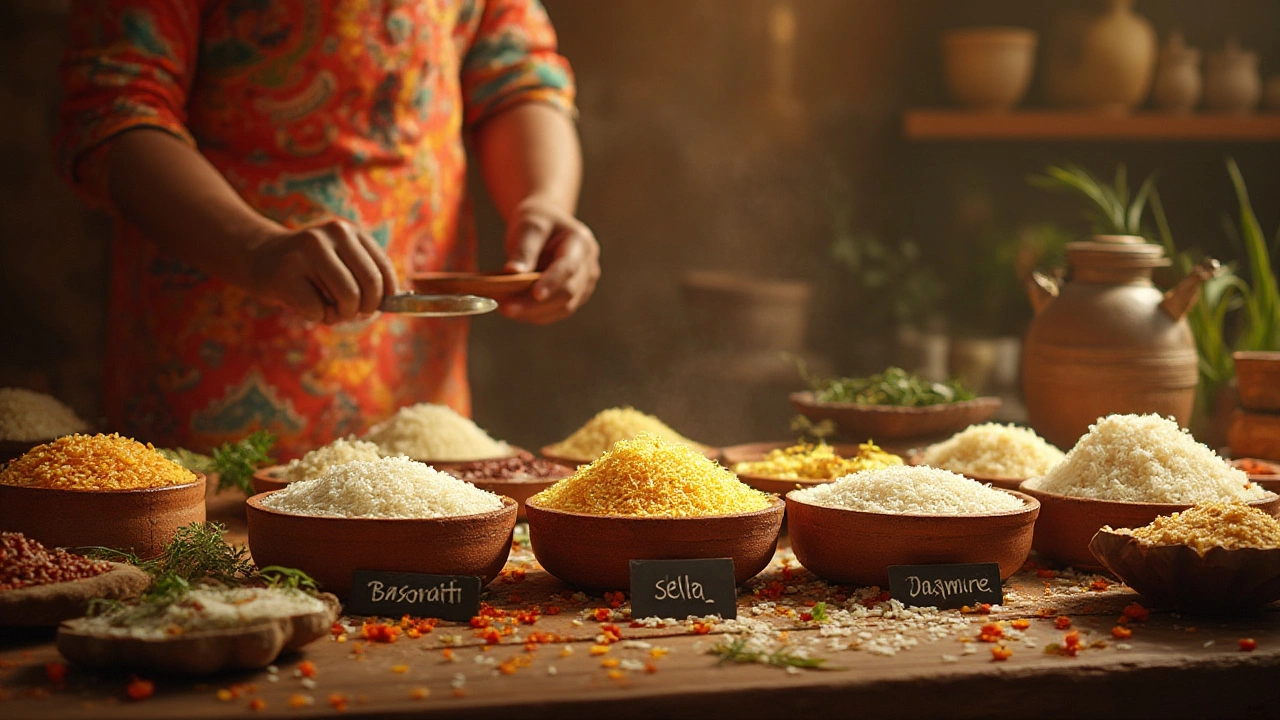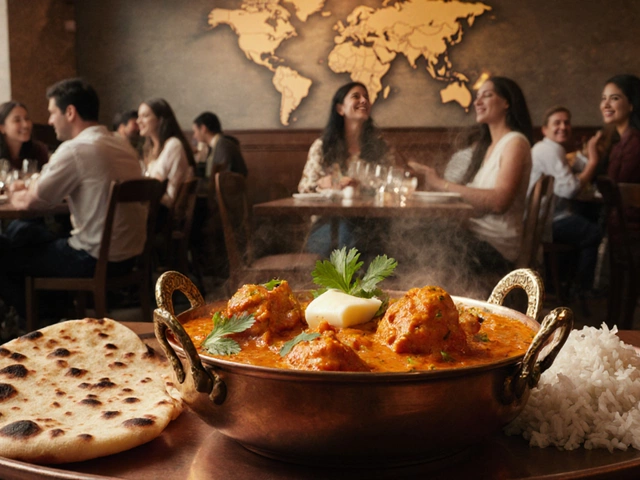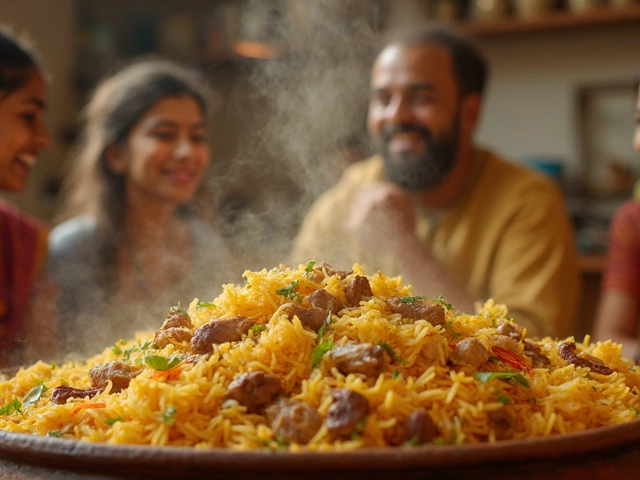Sometimes a meal stops you in your tracks before you’ve even taken a bite. Biryani is that kind of dish—aromatic rice, tender meat or veggies, complex spices. But the real backbone? The rice itself. You could use the world's finest saffron and the freshest mint, but if your rice turns out mushy or lacks fragrance, the whole thing falls flat. This isn’t just about taste. The grain, length, aroma, and even the age of the rice can make or break the biryani experience. People guard their favorite rice brands like family heirlooms. And seriously, no one talks about rice like biryani lovers do. Is there a right answer? Or do you need to taste every kind of rice out there?
Why Rice Matters in Biryani
Ask anyone who’s grown up eating biryani, and they’ll tell you—the choice of rice is not just a minor detail. It’s what makes biryani an occasion. Even the best cooks in Hyderabad or Lucknow don’t skimp on the grains. Rice gives biryani its signature look: long, separate, aromatic grains that soak up spice yet refuse to be sticky. If you open a pot and find clumps, you know something went wrong. The thing is, biryani originated as a royal dish, often cooked for rulers and special guests. It’s not just food—it's tradition, celebration, and ritual in a single pot. That explains why the type of rice can spark heated debates at family tables from India to Pakistan and beyond.
For many, the gold standard is basmati, but there’s more to the story. Basmati is famous for its fragrance and long, slender grains. There's a reason the name means "queen of fragrance" in Hindi. But even within basmati, there are huge differences: old vs. new crop, local vs. exported, as well as subvarieties grown in the Himalayan foothills. Some chefs even swear by aged basmati—with at least one or two years of age—claiming it remains fluffy and non-sticky, even after repeated layers of steaming. It’s not just hype; a study from Punjab Agricultural University showed that aged basmati holds flavor and shape better due to reduced moisture content. That extra year of patience pays off on the plate.
But basmati isn’t the only rice that has found a home in biryani. In Telangana or Tamil Nadu, you might come across small-grain seeraga samba rice. Short, chubby, very aromatic—some say it’s perfect for soaking up South Indian-style biryani masala. Others will experiment with sella basmati, a parboiled, golden version that’s strong enough to survive commercial kitchen chaos. The texture, fragrance, and even the color of cooked rice all carry meaning. It's almost like people can tell where a biryani comes from just by looking at the grains.
The Popular Rice Varieties for Biryani
So which rice really stands out in a lineup? First, let’s take a look at the most popular contenders and see what makes them special for biryani, no matter where you are:
- Basmati Rice – This is the big one. Long, slender, and delicately scented, especially if aged. Most traditional biryani recipes (particularly north Indian and Pakistani) ask for aged basmati for its ability to stay separate and never wet.
- Seeraga Samba – The favorite for South Indian biryanis, like the legendary Dindigul version. This grain is tiny, almost round, but super aromatic. It absorbs spices like a sponge, giving the biryani a deeper, Earthier flavor.
- Jeerakasala/Khaima Rice – Exclusive to Kerala’s Malabar biryani. Short, slightly chubby, and quick to cook. Jeerakasala rice soaks up coconut and fried onion flavors beautifully—making it unique.
- Sella Basmati (Parboiled) – Think of this as basmati with extra resilience. It’s already parboiled, so it doesn’t break down with long cooking. Perfect for restaurant-scale portions or dum biryanis where rice must endure long steaming.
- Other regional varieties – Sometimes people experiment with local grains like Gobindo Bhog (West Bengal) or Ambemohar (Maharashtra), usually for festival or homestyle biryanis.
The most common problem with trying unfamiliar rice? Poor texture. Some grains swell too much and burst, or clump together. Others simply vanish under masala, leaving a disappointing porridge. That’s why so many stick with trusted brands and types—it’s risky to experiment on biryani night.
| Rice Type | Region/Use | Grain Length | Texture | Special Feature |
|---|---|---|---|---|
| Basmati | North India, Pakistan, global | Long, slender | Fluffy, separate | Highly aromatic |
| Seeraga Samba | Tamil Nadu, South India | Short, round | Soft but non-sticky | Intense absorption of spices |
| Sella Basmati | North India, restaurants | Long, golden | Firm, resilient | Withstands heavy steam |
| Jeerakasala/Khaima | Kerala | Short, chubby | Light, fluffy | Quick cooking |
Fun fact: India alone produces over 70% of the world’s basmati rice, with the state of Haryana exporting the lion’s share. But each “basmati” crop can vary by year—rainfall and soil impact everything from fragrance to length. It’s a flavor lottery you don’t get with industrial white rice. Of course, some home cooks have favorites they swear by, usually after years (sometimes decades!) of trial and error. I remember my grandmother refusing to touch any batch of biryani rice unless she could smell the uncooked grains from five feet away.

How to Select the Perfect Rice for Your Biryani
The search for the perfect rice goes beyond just picking basmati off a supermarket shelf. Here’s what the experts (and obsessive biryani lovers) look for every single time:
- Grain Length: Longer grains translate to that luxurious, restaurant-style biryani. Aged basmati grains can triple in length after cooking.
- Fragrance: This is huge! The rice should smell faintly sweet or nutty even before cooking. If it’s musty or bland, skip it.
- Purity: Some brands blend different grains—avoid these if possible. Pure basmati or samba delivers far better consistency.
- Age: Rice that’s been stored for at least a year behaves much better—less starch, more aroma, and better texture. Many high-end brands even label the crop year.
- Origin: Some swear by Dehradun, Punjab, or Uttarakhand basmati—the altitude and soil work magic on the grain’s development.
- Processing: Parboiled (sella) rice is good for certain biryanis, but not all. Know which style you want before buying.
Everybody has stories about the “perfect” biryani rice. I asked my friend Amrita, a food scientist in Mumbai, for her best tip. She swears by soaking the rice for at least thirty minutes before cooking. Not just a random suggestion—soaking helps elongate grains and reduces the risk of breakage when boiling. Another tip? Don’t stir! Agitation causes even the best grains to break apart and clump, ruining that fluffy, regal finish.
If you want to nerd out, some rice companies publish data about their moisture content and average grain length. Any number above 7mm uncooked is a sign of serious basmati quality. The world record for the longest cooked basmati grain is over 22mm! Most standard grades will be 6-7mm before cooking, stretching to about 15-18mm afterward when handled right.
Is it worth paying extra for organic or heritage basmati brands? Sometimes yes, sometimes no. Many mid-tier brands in India and Pakistan use the same fields as the fancier ones but skip the branding. Always try a small batch before springing for a big bag, and see which suits your own style of biryani.
Cooking Techniques: How to Get the Most Out of Your Rice
Even the best rice can turn into a sticky mess without some careful thought. Here’s the lowdown on cooking biryani rice the right way, whether you like old-school dum (slow-cooked under a lid) or prefer a quick oven bake.
Start by rinsing the rice thoroughly. This removes surface starch and stops clumping. My dog Milo knows it’s biryani day because of the sound of rice being rinsed in the kitchen sink. I aim for at least three washes, or until the water runs almost clear. Then, soak your rice for 30 minutes—this prevents the shock of sudden boiling and helps grains get that pretty, slender stretch.
Salt your boiling water like the sea. Another pro move: Add a couple tiny drops of lemon juice or a splash of oil—this keeps grains separate without changing the taste. Boil the rice until it’s about 70% cooked—still a bit firm in the middle, but not crunchy. Scoop out and drain fast, then use right away for layering with your masala mix in a heavy pot or oven dish.
For dum biryani, layering is everything. Start with a little rice at the bottom, then masala, more rice, meat or vegetables, and keep alternating. Always finish with a rice layer, topped with saffron-infused milk, fried onions, and a few mint leaves. Seal the pot tightly. If you’re old school, you’ll use dough to cement the lid and trap steam.
Heat management is the final frontier. Too hot, and the bottom layer scorches. Too cool, and the rice stays undercooked. A trick from Hyderabad? Place the sealed pot directly on a flat griddle (tava) instead of the flame—this spreads heat more evenly. The result is magical: each grain holds its own, even with saucy masala on top. No soggy blobs, no crunchy surprises, just dazzling best rice for biryani flavor.
Here are a few bonus do’s and don’ts:
- Don’t oversoak, or rice could split.
- Never stir rice after pre-cooking—drain and layer gently instead.
- Let the biryani rest for ten minutes after cooking, covered. This helps the rice settle and finish absorbing aromatic steam.
- Always fluff with a fork—never a spoon.
- Store uncooked rice in a cool, dry place. Away from strong odors (rice absorbs everything!)
Of course, if you find a brand or style of rice that feels “just right” to you, don’t let tradition box you in. I grew up eating biryani with local Kolam rice—low fragrance, short grain, but cooked fluffy enough to impress anyone who tried it. Sometimes, the best biryani is about family rituals, not rules.
Next biryani weekend, sneak a little experiment. Serve two types of rice side by side and watch people debate, question, and eventually argue which was best. Turns out, the secret to biryani bliss could simply be the rice we grew up loving—or the new favorite we discover next.
- Poplular Tags
- best rice for biryani
- basmati rice
- biryani tips
- biryani recipe
- types of rice











